|
#26- Bolivia
Jeff Willner - 30 January, 2002
(La Paz, BOLIVIA) � Bolivia has a reputation for being inexpensive yet
beautiful but nobody bothers to mention how high it is - or maybe I wasn't
paying attention. I got smart real fast as we left the border of Chile
and started climbing inexorably up. We started at 2700m in Chile, by the
time we reached the Bolivian border post a dozen kilometers away we were
at 4300m. In Africa, it took several days of climbing Kilimanjaro to reach
that altitude. Here we had driven up in a couple minutes. Jody had never
been at altitude before and was confused. Why did she feel so dizzy, out
of breath, with a pounding headache? It's the details that get you. We
had signed up for a three-day, 4x4 tour through the Atacama desert in southern
Bolivia, but we didn't bother to check the altitude. It turned out that
we would be around 4500m for three days.
Jody ended up missing the entire tour. She went straight to Uyuni, the
endpoint, and was barely able to get around for a couple of days. Sally
and I were less affected, but still relied on cocoa leaves and Advil to
get us through. Our lungs had been at sea-level for six months and it was
hard to appreciate the beauty in the rare air. After the Atacama tour we
dodged bus strikes to go north to Potosi and La Paz, the two highest cities
in the world. It is pretty inconvenient not having the Land Rover and the
comfort level of the busses dropped a huge notch from Chile. But roads
are terrifying in Bolivia. Almost all are narrow dirt lanes through mountains,
traffic squeezes past with inches to spare, and the sides drop off thousands
of feet. I would probably have lost several years off the end of my life
in sheer stress having to drive those roads. We stopped looking out the
windows after awhile - better not to know. Still, Bolivia's reputation
is deserved. There are sights like the Salar de Uyuni (Uyuni Salt Lake)
and Potosi mines that are totally unique. Just keep the oxygen handy.
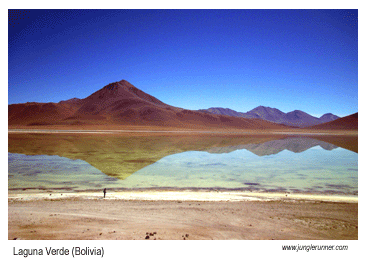 |
The Laguna Verde lies in the far southeast corner of
the country. At 4300m, it is a desolate, treeless
landscape. Oddly though, the flamingos thrive in the mineral rich
waters that run off the surrounding volcanoes. I always thought
of flamingos as wimpy birds, but I had to respect them when I was
popping the sixth Advil for the altitude headaches. The temperature
drops to -20C (-4F) at night. Beautiful country, but you have to
be willing to suffer a bit to see it. |
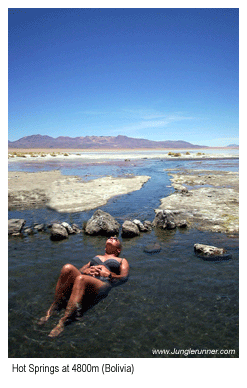  In the middle of the high altitude desolation we came across
some beautiful hot springs. I dangled my toes but Sally jumped right
in. Crazy Australians. Our guide proved to be a true jack of all
trades on the three day trip. Between driving and pointing out sights,
he cooked great meals and fixed the truck when it broke down. So
we weren't too hard on him when he slept in on the last morning.
We all woke up at 3:45am to see sunrise over the Salar de Uyuni (Uyuni
Salt Lake). The lake is a mineral sludge covered by a crust of salt
(very dangerous in some sections). In the middle of the high altitude desolation we came across
some beautiful hot springs. I dangled my toes but Sally jumped right
in. Crazy Australians. Our guide proved to be a true jack of all
trades on the three day trip. Between driving and pointing out sights,
he cooked great meals and fixed the truck when it broke down. So
we weren't too hard on him when he slept in on the last morning.
We all woke up at 3:45am to see sunrise over the Salar de Uyuni (Uyuni
Salt Lake). The lake is a mineral sludge covered by a crust of salt
(very dangerous in some sections). |
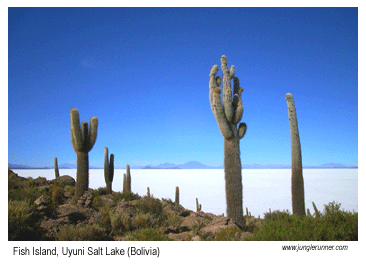 |
Sunrise over Uyuni Salt Lake was the
highlight of three day excursion. It felt as through we were driving
across ice in the pre-dawn cold. And even more weird was "docking" at
an island in the middle of the lake. We drove off the salt crust
onto the shore and had breakfast.
Tourism is taking off in southern Bolivia. Formerly a very
rugged prospect, nowadays there are dozens of 4x4s criss-crossing
the Atacama. We were lucky to get to Fish Island so early. We
had it to ourselves for several hours. Hundreds of cactus glowed
in the morning sun and the vast lake gleamed white into the far
distance. It was an almost spiritual experience.
|
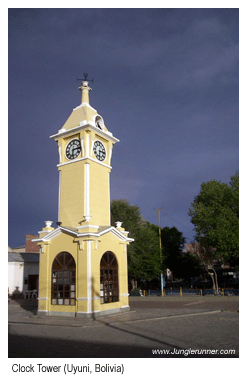 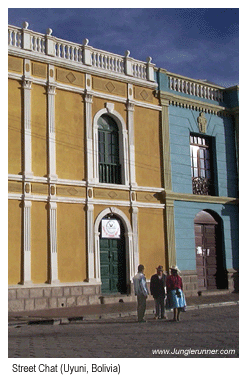 After three days of sand and sun we arrived in the little
town of Uyuni. A somewhat acclimated Jody was waiting for us at one
of the nicer hotels in town. Hot showers, restaurant food, and a
nap in a bed with sheets. Ohhh, sweet luxury. There was a
bus strike in town but we managed to get tickets for the next day's
bus to Potosi. We were crammed in the back for seven hours with a
dozen gentlemen whose idea of hygiene must be 'a shower a week whether
I need it or not'. But we were lucky. Some friends who had
gone one day earlier endured thirteen hours instead of seven because
of striker roadblocks. Evidently strikes are quote common. Sounds
very French to me. After three days of sand and sun we arrived in the little
town of Uyuni. A somewhat acclimated Jody was waiting for us at one
of the nicer hotels in town. Hot showers, restaurant food, and a
nap in a bed with sheets. Ohhh, sweet luxury. There was a
bus strike in town but we managed to get tickets for the next day's
bus to Potosi. We were crammed in the back for seven hours with a
dozen gentlemen whose idea of hygiene must be 'a shower a week whether
I need it or not'. But we were lucky. Some friends who had
gone one day earlier endured thirteen hours instead of seven because
of striker roadblocks. Evidently strikes are quote common. Sounds
very French to me.
|
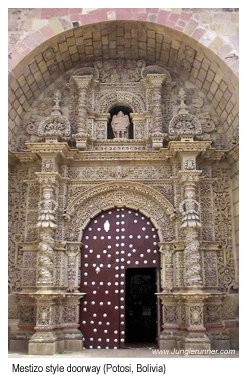  Potosi is renowned for its silver. The mines in the
Cerro Rico mountains were were the world's most prolific, funding
the Spanish economy and its monarch's extravagance for more than
two centuries. It is estimated that as many as eight million conscripted
Indians and African slaves died working the mines during colonial
times. During a tour of the colonial mint we saw footprints worn
into the board floors from slaves who pounded out the silver coins
in the same place for decades. Most African slaves only lived six
months. Done in by the elevation and cold. Potosi is a striking town
to visit for its many beautiful churches and buildings - and the
sombre shadow of the mines that funded it all. Potosi is renowned for its silver. The mines in the
Cerro Rico mountains were were the world's most prolific, funding
the Spanish economy and its monarch's extravagance for more than
two centuries. It is estimated that as many as eight million conscripted
Indians and African slaves died working the mines during colonial
times. During a tour of the colonial mint we saw footprints worn
into the board floors from slaves who pounded out the silver coins
in the same place for decades. Most African slaves only lived six
months. Done in by the elevation and cold. Potosi is a striking town
to visit for its many beautiful churches and buildings - and the
sombre shadow of the mines that funded it all. |
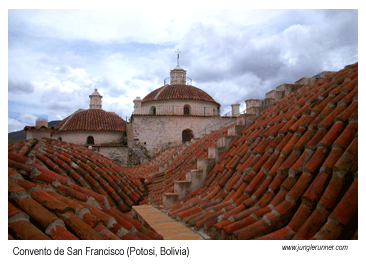 |
By the last bit of Bolivia I was into
my black zone, a bit of depression that seems to hit me every month.
Jody and Sally went off alone to visit the silver mines in Potosi,
and the rather unique prison tour in La Paz (done by the prisoners
themselves). Sometimes it can be tough to keep going. Sure the sights
are life-changing, amazing, never to be repeated - but so what, I
just want a decent pizza and paved roads. These moods pass, I've
figured out in my old age that I need extra sugar and more rest in
the down times. So oxygen-starved sleep and empanadas that gave me
stomach bugs were not what the doctor ordered. Doubled over on the
hostel bed with cramps for four hours put me in a sour frame of mind. |
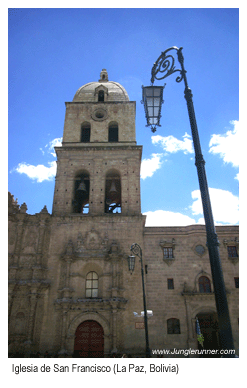 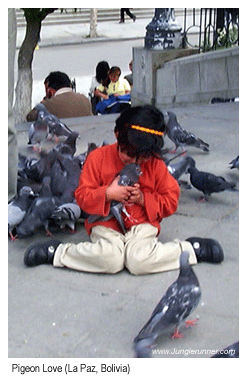 "I don't want to go back to La Paz",
Sally said to us when we were planning our bus tickets. "I spent
six days there, and that was too much." She came along anyway
(what a trooper) but after spending a day walking around I can see
her point. The city is waaaaay up there. Bolivia is the Tibet of
the Americas and La Paz is the capitol. Situated in a long deep canyon,
there is virtually no level ground. Everywhere is a steep uphill
climb (you don't remember the downhill ones). Though we sampled some
fine cuisine in one of the posh neighbourhoods and enjoyed an excellent
modern art museum, most of the city reflects the poverty of the country
- dirty and shabby. "I don't want to go back to La Paz",
Sally said to us when we were planning our bus tickets. "I spent
six days there, and that was too much." She came along anyway
(what a trooper) but after spending a day walking around I can see
her point. The city is waaaaay up there. Bolivia is the Tibet of
the Americas and La Paz is the capitol. Situated in a long deep canyon,
there is virtually no level ground. Everywhere is a steep uphill
climb (you don't remember the downhill ones). Though we sampled some
fine cuisine in one of the posh neighbourhoods and enjoyed an excellent
modern art museum, most of the city reflects the poverty of the country
- dirty and shabby. |
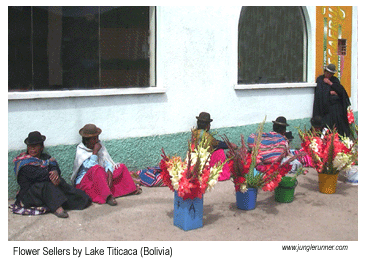 |
With the silver gone,
very little infrastructure, and almost no industry, modern-day Bolivia
is struggling to find a way back to its opulent past. It was with
a bit of relief that I left La Paz toward Lake Titicaca and Peru
- I've been there before and can't wait to chill out in Arequipa.
Still, I'm glad I visited Bolivia. I will definitely remember the
'high' life. There is something to be said for visiting the hard
spots - you know that the Indian women didn't put the hats on just
for the tourists, that's the way it really is. And there is a certain
reward you feel inside for enduring the crap to be there. |
|

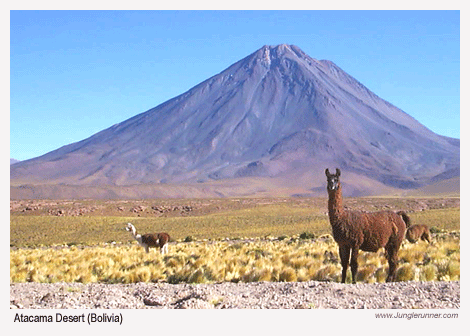


 In the middle of the high altitude desolation we came across
some beautiful hot springs. I dangled my toes but Sally jumped right
in. Crazy Australians. Our guide proved to be a true jack of all
trades on the three day trip. Between driving and pointing out sights,
he cooked great meals and fixed the truck when it broke down. So
we weren't too hard on him when he slept in on the last morning.
We all woke up at 3:45am to see sunrise over the Salar de Uyuni (Uyuni
Salt Lake). The lake is a mineral sludge covered by a crust of salt
(very dangerous in some sections).
In the middle of the high altitude desolation we came across
some beautiful hot springs. I dangled my toes but Sally jumped right
in. Crazy Australians. Our guide proved to be a true jack of all
trades on the three day trip. Between driving and pointing out sights,
he cooked great meals and fixed the truck when it broke down. So
we weren't too hard on him when he slept in on the last morning.
We all woke up at 3:45am to see sunrise over the Salar de Uyuni (Uyuni
Salt Lake). The lake is a mineral sludge covered by a crust of salt
(very dangerous in some sections). 

 After three days of sand and sun we arrived in the little
town of Uyuni. A somewhat acclimated Jody was waiting for us at one
of the nicer hotels in town. Hot showers, restaurant food, and a
nap in a bed with sheets. Ohhh, sweet luxury. There was a
bus strike in town but we managed to get tickets for the next day's
bus to Potosi. We were crammed in the back for seven hours with a
dozen gentlemen whose idea of hygiene must be 'a shower a week whether
I need it or not'. But we were lucky. Some friends who had
gone one day earlier endured thirteen hours instead of seven because
of striker roadblocks. Evidently strikes are quote common. Sounds
very French to me.
After three days of sand and sun we arrived in the little
town of Uyuni. A somewhat acclimated Jody was waiting for us at one
of the nicer hotels in town. Hot showers, restaurant food, and a
nap in a bed with sheets. Ohhh, sweet luxury. There was a
bus strike in town but we managed to get tickets for the next day's
bus to Potosi. We were crammed in the back for seven hours with a
dozen gentlemen whose idea of hygiene must be 'a shower a week whether
I need it or not'. But we were lucky. Some friends who had
gone one day earlier endured thirteen hours instead of seven because
of striker roadblocks. Evidently strikes are quote common. Sounds
very French to me.

 Potosi is renowned for its silver. The mines in the
Cerro Rico mountains were were the world's most prolific, funding
the Spanish economy and its monarch's extravagance for more than
two centuries. It is estimated that as many as eight million conscripted
Indians and African slaves died working the mines during colonial
times. During a tour of the colonial mint we saw footprints worn
into the board floors from slaves who pounded out the silver coins
in the same place for decades. Most African slaves only lived six
months. Done in by the elevation and cold. Potosi is a striking town
to visit for its many beautiful churches and buildings - and the
sombre shadow of the mines that funded it all.
Potosi is renowned for its silver. The mines in the
Cerro Rico mountains were were the world's most prolific, funding
the Spanish economy and its monarch's extravagance for more than
two centuries. It is estimated that as many as eight million conscripted
Indians and African slaves died working the mines during colonial
times. During a tour of the colonial mint we saw footprints worn
into the board floors from slaves who pounded out the silver coins
in the same place for decades. Most African slaves only lived six
months. Done in by the elevation and cold. Potosi is a striking town
to visit for its many beautiful churches and buildings - and the
sombre shadow of the mines that funded it all.

 "I don't want to go back to La Paz",
Sally said to us when we were planning our bus tickets. "I spent
six days there, and that was too much." She came along anyway
(what a trooper) but after spending a day walking around I can see
her point. The city is waaaaay up there. Bolivia is the Tibet of
the Americas and La Paz is the capitol. Situated in a long deep canyon,
there is virtually no level ground. Everywhere is a steep uphill
climb (you don't remember the downhill ones). Though we sampled some
fine cuisine in one of the posh neighbourhoods and enjoyed an excellent
modern art museum, most of the city reflects the poverty of the country
- dirty and shabby.
"I don't want to go back to La Paz",
Sally said to us when we were planning our bus tickets. "I spent
six days there, and that was too much." She came along anyway
(what a trooper) but after spending a day walking around I can see
her point. The city is waaaaay up there. Bolivia is the Tibet of
the Americas and La Paz is the capitol. Situated in a long deep canyon,
there is virtually no level ground. Everywhere is a steep uphill
climb (you don't remember the downhill ones). Though we sampled some
fine cuisine in one of the posh neighbourhoods and enjoyed an excellent
modern art museum, most of the city reflects the poverty of the country
- dirty and shabby. 